Longitudinal–Torsional Ultrasonic Grinding of GCr15: Development of Longitudinal–Torsional Ultrasonic System and Prediction of Surface Topography
Abstract
:1. Introduction
2. Development of LTUG System
2.1. Development of Longitudinal Horn
2.2. Design of Longitudinal–Torsional Ultrasonic Horn
2.3. Amplitude Test of LTUG System
3. Surface Topography Prediction of LTUG
3.1. Maximum Undeformed Cutting Thickness Model Considering Elastic Deformation
3.2. Surface Topography Model of LTUG
4. The Surface Morphology Model Test of Gcr15 Bearing Ring Internal Circle in LTUG
4.1. Test Conditions and Measurement Methods
4.2. Test Verification of Surface Topography Prediction Model of LTUG
4.3. Multi-Objective Parameter Optimization and Verification Based on Response Surface Method
5. Conclusions
Author Contributions
Funding
Data Availability Statement
Conflicts of Interest
References
- Giemza, B.; Nowiński, E.; Domański, M. Gas-Dynamic Foil Bearings Application in High-Speed Turbines. J. Konbin 2015, 27, 99–108. [Google Scholar] [CrossRef]
- Xue, P.; Jiang, Y.; Wang, H.; He, H. Accurate Detection Method of Aviation Bearing Based on Local Characteristics. Symmetry 2019, 11, 1069. [Google Scholar] [CrossRef]
- Schmidt, A.A.; Plánka, J.; Schmidt, T.; Grabherr, O.; Bartel, D. Validation of a dry sliding wear simulation method for wastegate bearings in automotive turbochargers. Tribol. Int. 2021, 155, 106711. [Google Scholar] [CrossRef]
- Gao, X.; Yan, C.; Liu, Y.; Yan, P.; Yang, J.; Wu, L. A 4-DOF dynamic model for ball bearing with multiple defects on raceways. Proc. Inst. Mech. Eng. Part K J. Multi-Body Dyn. 2021, 235, 3–18. [Google Scholar] [CrossRef]
- Liu, J.; Wu, H.; Shao, Y. The influence of the raceway thickness on the dynamic performances of a roller bearing. J. Strain Anal. Eng. Des. 2017, 52, 528–536. [Google Scholar] [CrossRef]
- Li, Q.; Pan, C.; Jiao, Y.; Hu, K. Research on PCBN Tool Dry Cutting GCr15. Machines 2018, 6, 28. [Google Scholar] [CrossRef]
- Manieri, F.; Stadler, K.; Morales-Espejel, G.E.; Kadiric, A. The origins of white etching cracks and their significance to rolling bearing failures. Int. J. Fatigue 2019, 120, 107–133. [Google Scholar] [CrossRef]
- Arakere, N.K. Gigacycle rolling contact fatigue of bearing steels: A review. Int. J. Fatigue 2016, 93, 238–249. [Google Scholar] [CrossRef]
- Kan, Z.; Wenhe, L.; Lianjun, S.; Heng, M. Investigation on grinding temperature in ultrasonic vibration-assisted grinding of zirconia ceramics. Mach. Sci. Technol. 2019, 23, 612–628. [Google Scholar] [CrossRef]
- Xu, L.-H.; Na, H.-B.; Han, G.-C. Machinablity improvement with ultrasonic vibration–assisted micro-milling. Adv. Mech. Eng. 2018, 10, 168781401881253. [Google Scholar] [CrossRef]
- Guo, M.; Lu, M.; Lin, J.; Gao, Q.; Du, Y. Modeling and investigation of minimum chip thickness for silicon carbide during quasi-intermittent vibration–assisted swing cutting. Int. J. Adv. Manuf. Technol. 2023, 127, 1691–1701. [Google Scholar] [CrossRef]
- Wang, Z.; Niu, Y.; Sun, H.; Jiao, F. Preparation and mechanism of copper ultra-fine grain strip by ultrasonic vibration extrusion cutting-model, FEM and experiment. J. Mater. Res. Technol. 2023, 24, 4919–4934. [Google Scholar] [CrossRef]
- Niu, Y.; Jiao, F.; Zhao, B.; Gao, G. Investigation of Cutting Force in Longitudinal-Torsional Ultrasonic-Assisted Milling of Ti-6Al-4V. Materials 2019, 12, 1955. [Google Scholar] [CrossRef]
- Chen, Y.; Su, H.; He, J.; Qian, N.; Gu, J.; Xu, J.; Ding, K. The Effect of Torsional Vibration in Longitudinal–torsional Coupled Ultrasonic Vibration-Assisted Grinding of Silicon Carbide Ceramics. Materials 2021, 14, 688. [Google Scholar] [CrossRef] [PubMed]
- Yang, Z.; Zhu, L.; Ni, C.; Ning, J. Investigation of surface topography formation mechanism based on abrasive-workpiece contact rate model in tangential ultrasonic vibration-assisted CBN grinding of ZrO2 ceramics. Int. J. Mech. Sci. 2019, 155, 66–82. [Google Scholar] [CrossRef]
- Gao, G.; Zhao, B.; Xiang, D.; Kong, Q. Research on the surface characteristics in ultrasonic grinding nano-zirconia ceramics. J. Mater. Process. Technol. 2009, 209, 32–37. [Google Scholar] [CrossRef]
- Xiao, C.-F.; Han, B. Research and Design of Ultra-long Ultrasonic Horn. J. Inst. Eng. Ser. C 2019, 100, 1015–1022. [Google Scholar] [CrossRef]
- Xiping, H.; Haidao, Z. Analytical and experimental study of an ultrasonic horn with a bend angle. J. Vib. Control 2018, 24, 4383–4394. [Google Scholar] [CrossRef]
- Yang, J.; Ji, S.; Zhao, J.; He, Q. Theoretical analysis and finite element calculation of ultrasonic horn. Mater. Sci. Eng. 2019, 612, 032032. [Google Scholar] [CrossRef]
- Hahn, M.; Cho, Y.; Jang, G.; Kim, B. Optimal Design and Experimental Verification of Ultrasonic Cutting Horn for Ceramic Composite Material. Appl. Sci. 2021, 11, 1954. [Google Scholar] [CrossRef]
- Zhou, M.; Zheng, W. A model for grinding forces prediction in ultrasonic vibration assisted grinding of SiCp/Al composites. Int. J. Adv. Manuf. Technol. 2016, 87, 3211–3224. [Google Scholar] [CrossRef]
- Hadhoum, L.; Loubar, K.; Paraschiv, M.; Burnens, G.; Awad, S.; Tazerout, M. Optimization of oleaginous seeds liquefaction using response surface methodology. Biomass-Convers Biorefin. 2020, 11, 2655–2667. [Google Scholar] [CrossRef]
- Hattab, M.W. On the use of data transformation in response surface methodology: A note on data transformation in response surface methodology. Qual. Reliab. Eng. Int. 2018, 34, 1185–1194. [Google Scholar] [CrossRef]
- Zhang, Y.; Li, C.; Chu, D.; Yan, G.; Zhu, M.; Zhao, X.; Gu, J.; Li, G.; Wang, J.; Zhang, B. Process optimization for the preparation of thiamethoxam microspheres by response surface methodology. React. Funct. Polym. 2020, 147, 104460. [Google Scholar] [CrossRef]
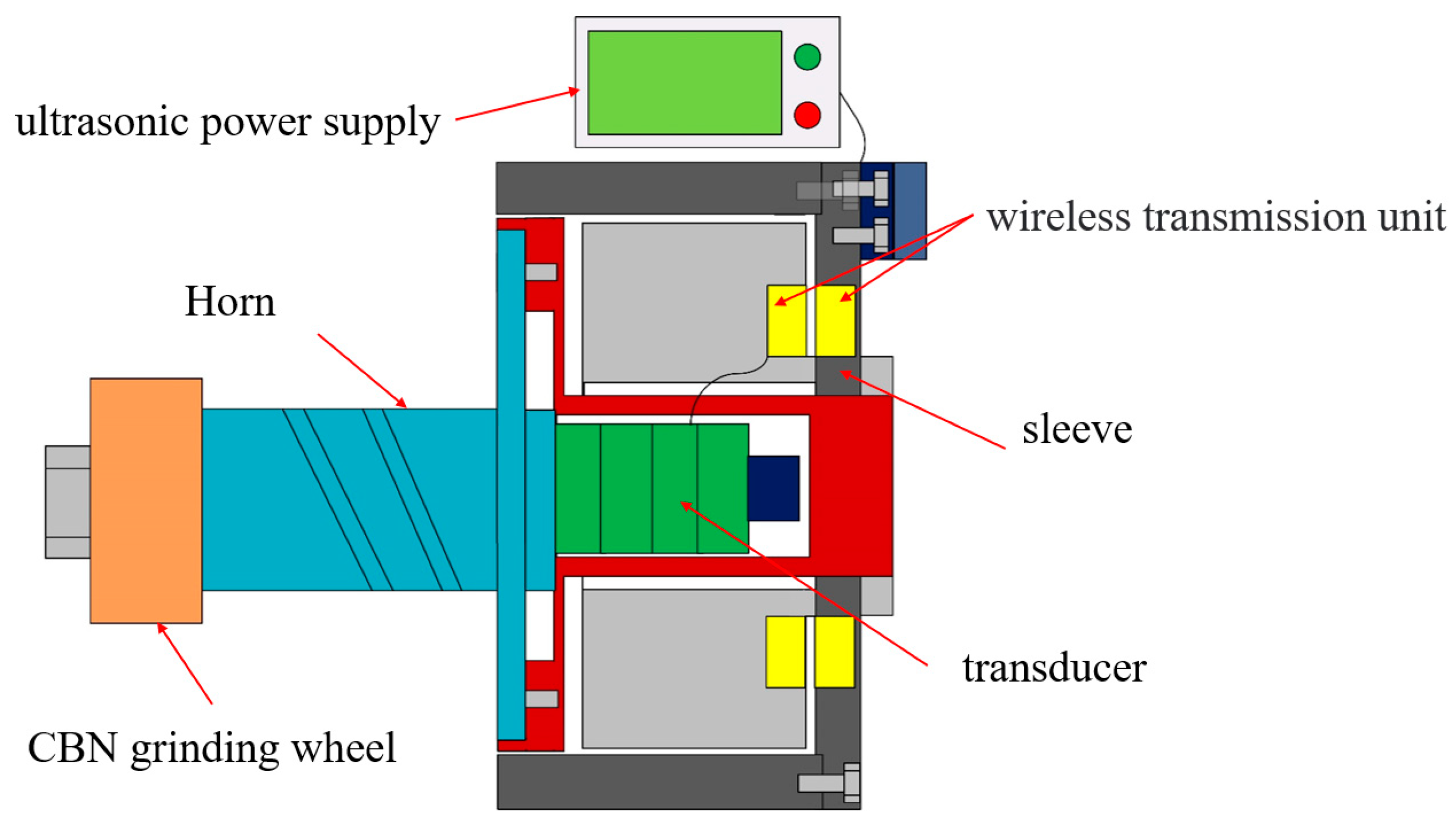






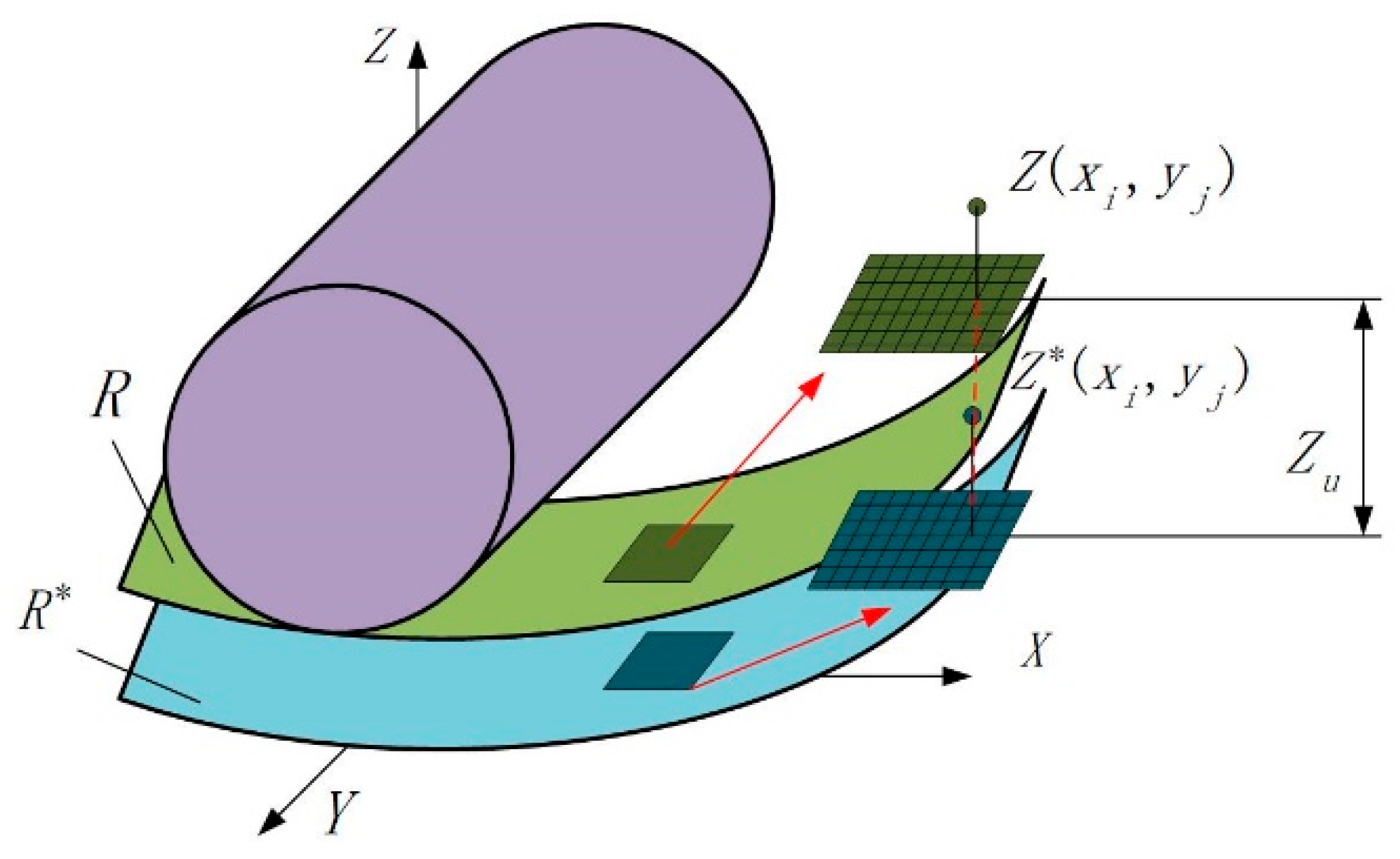
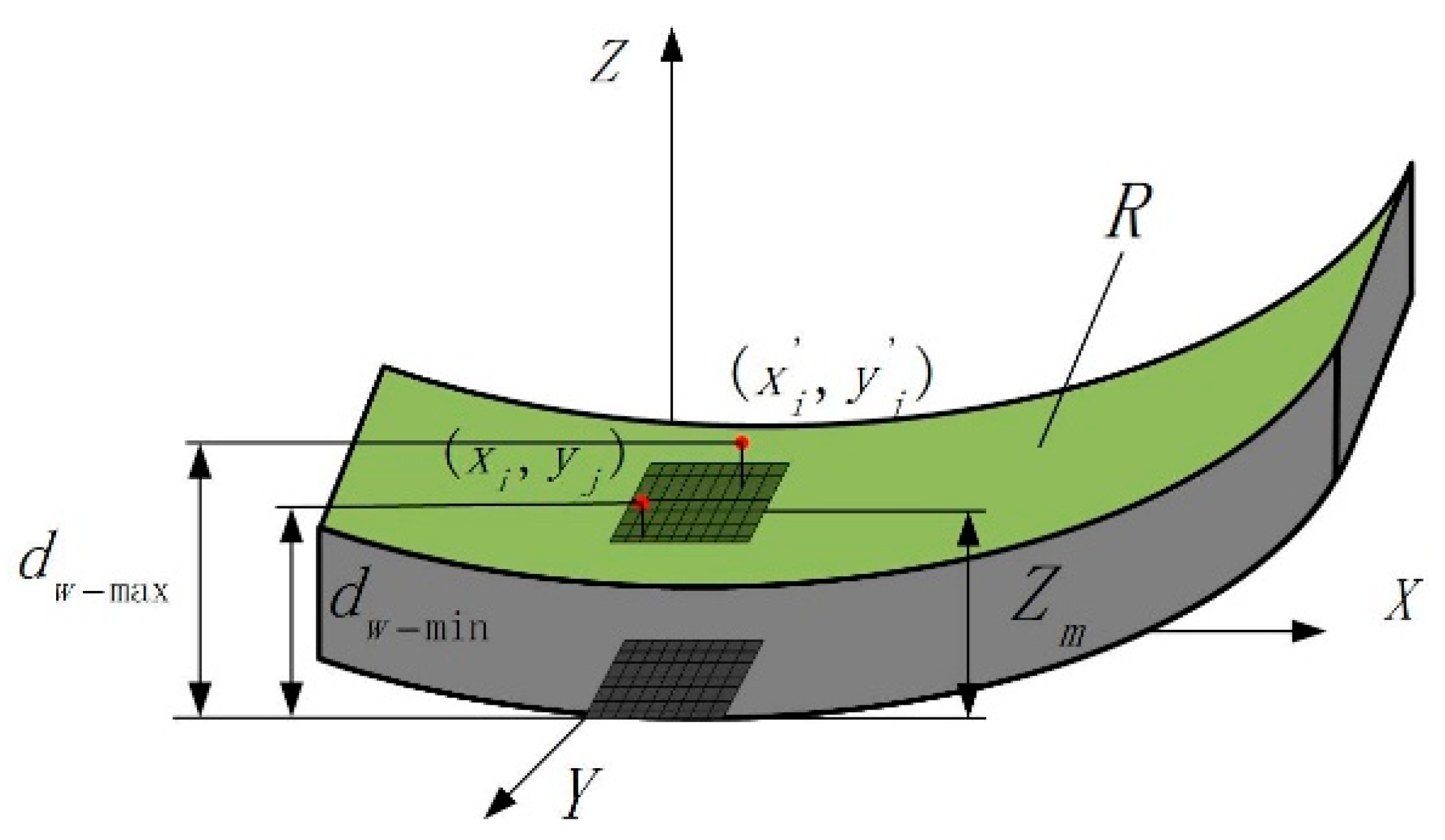
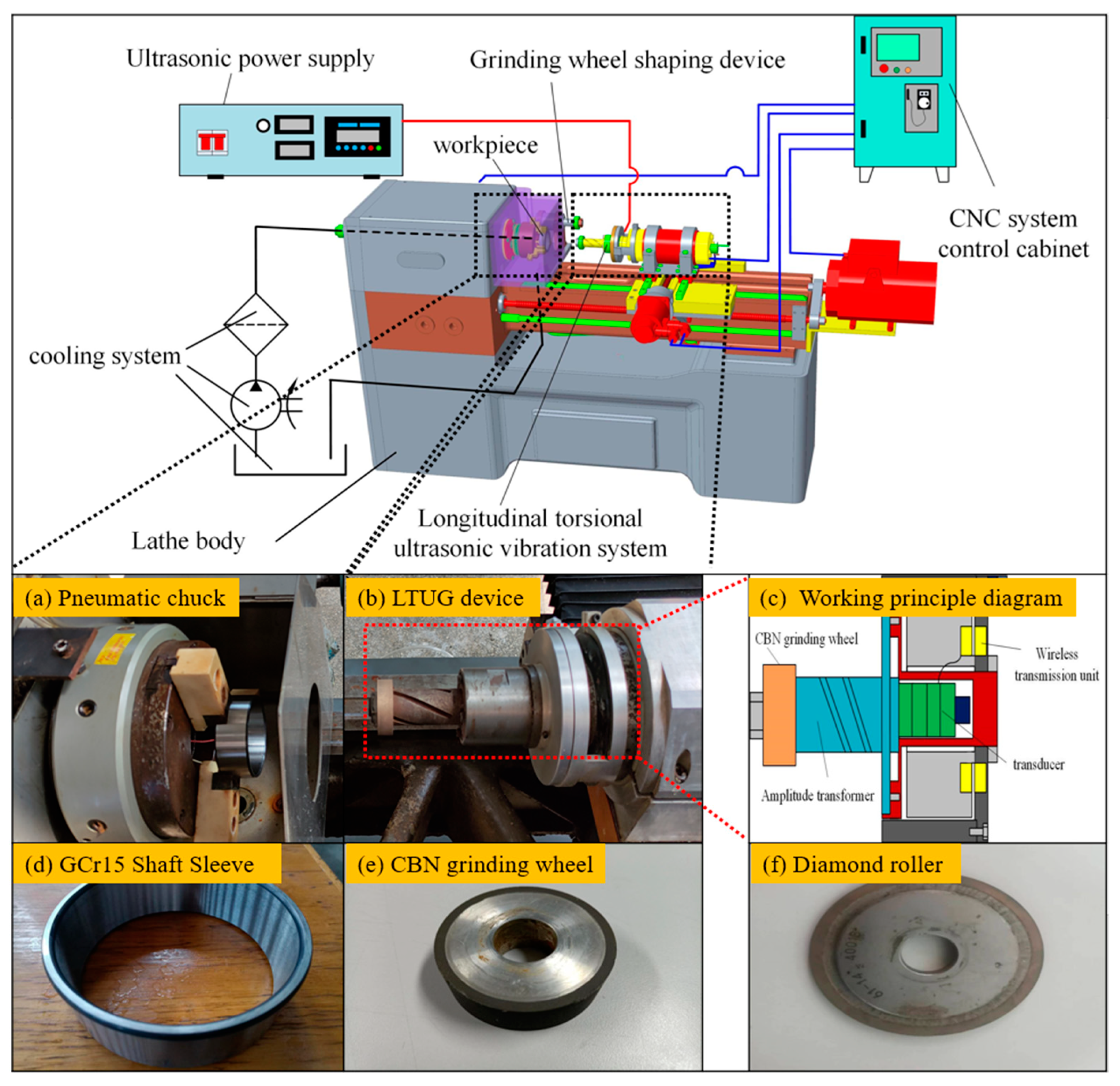

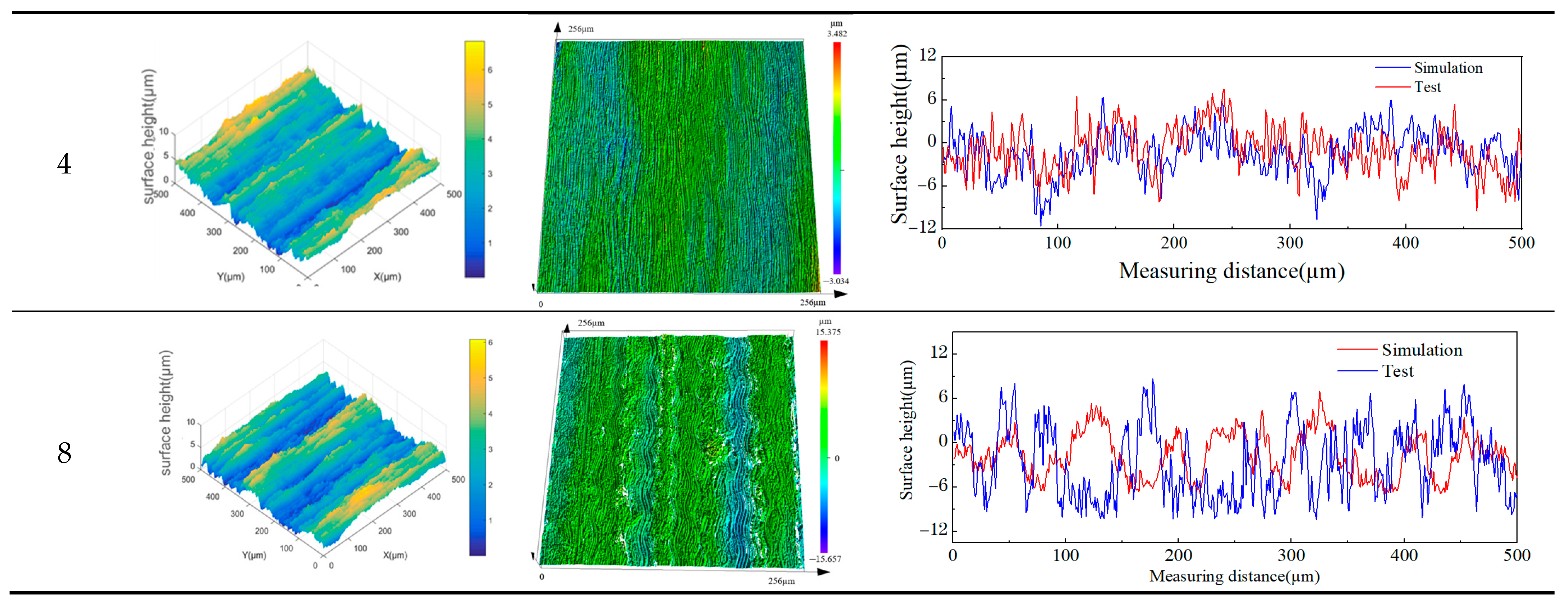
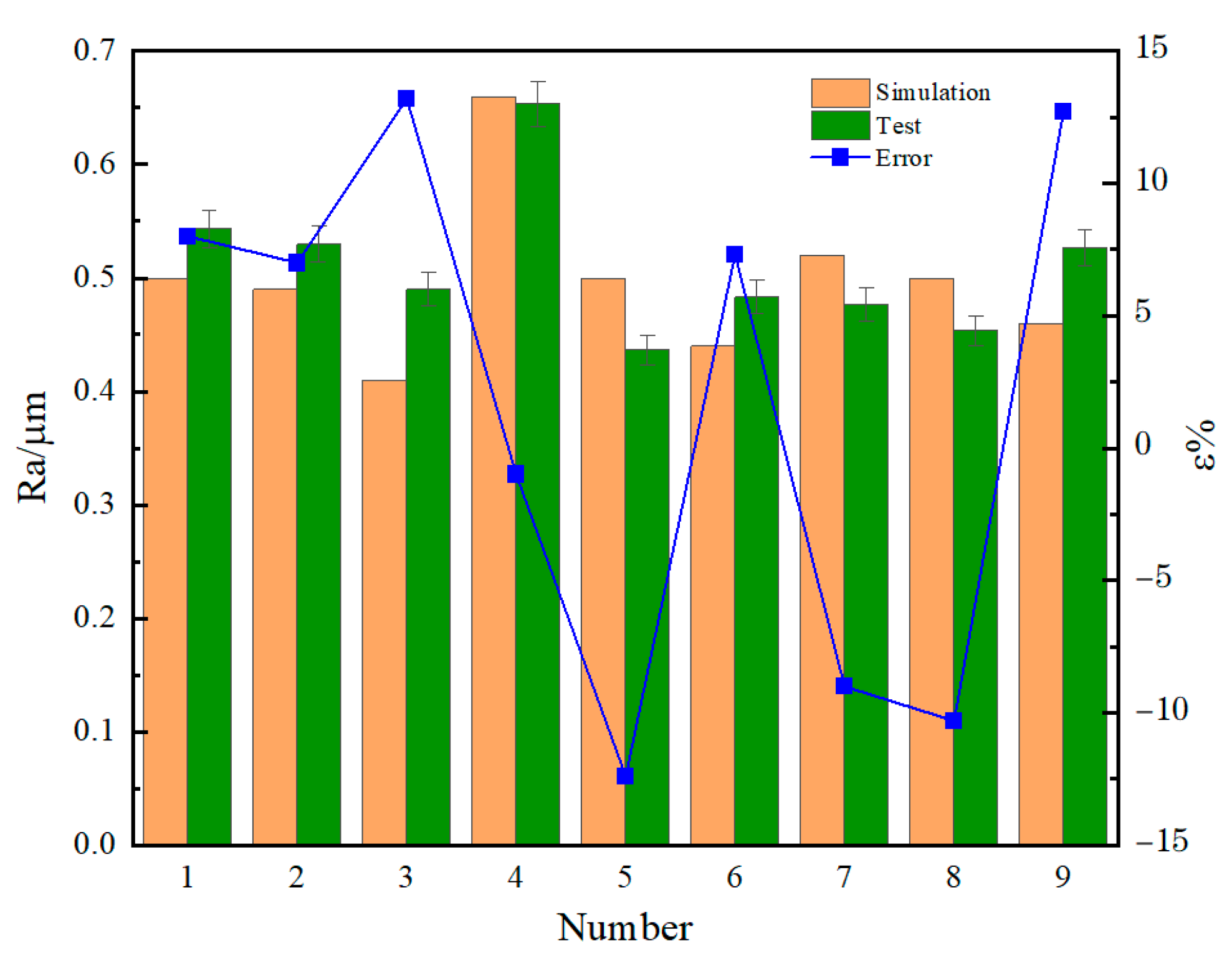

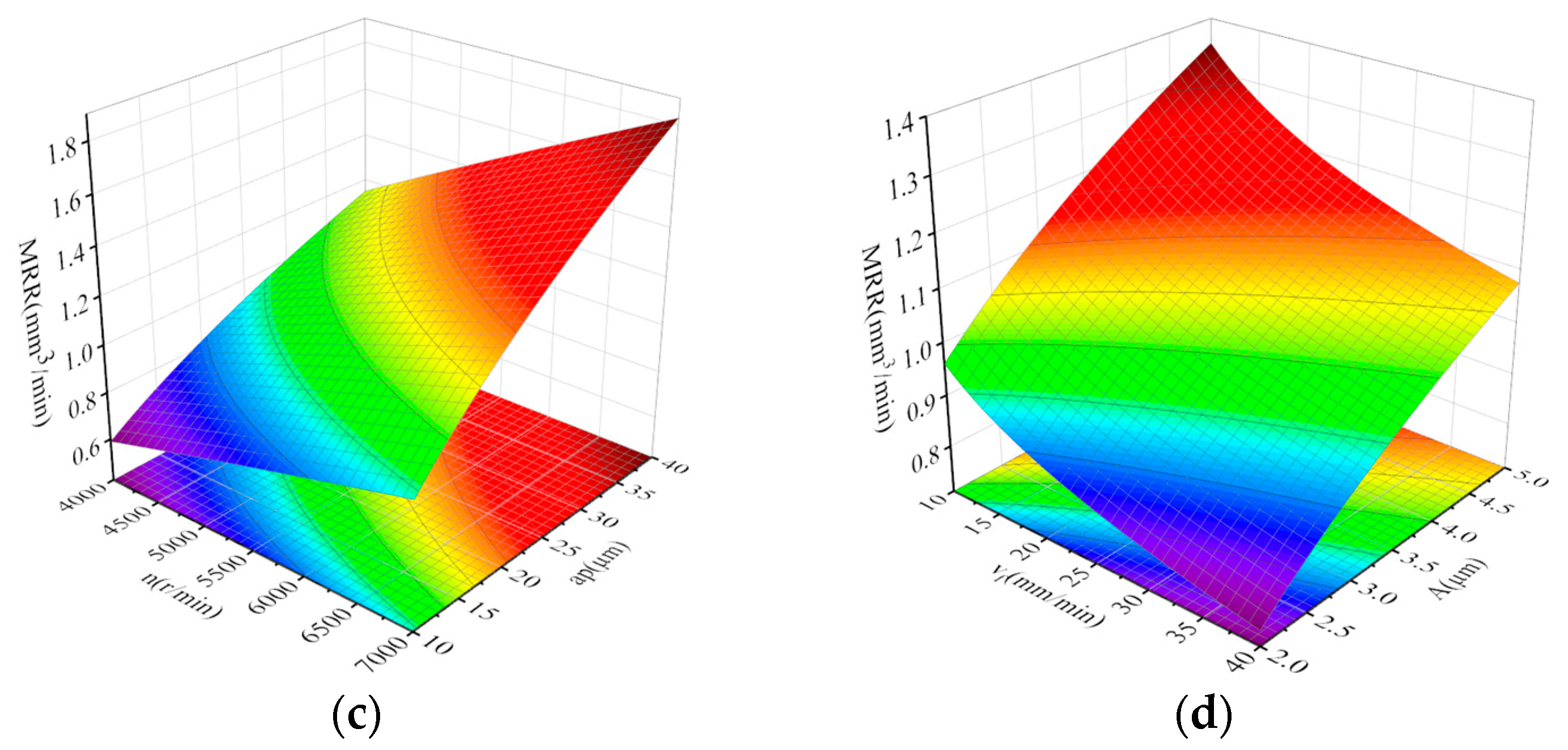
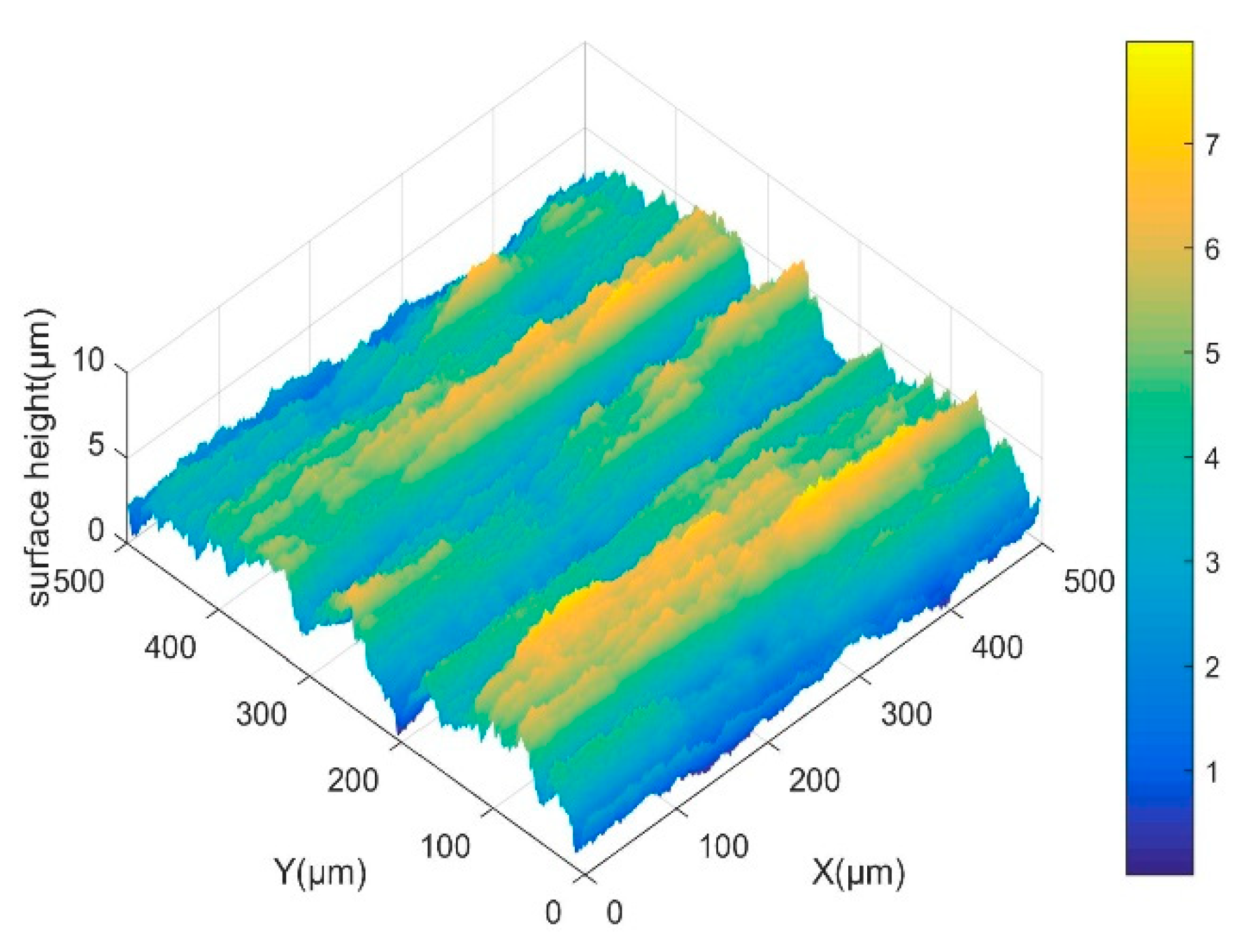

| Type | L/mm | L1/mm | D1/mm | D2/mm |
|---|---|---|---|---|
| Parameter | 182 | 33 | 38 | 20 |
| Number | Revolution Speed n (r/min) | Grinding Depth ap (um) | Feed Speed vf (mm/min) | Amplitude A (µm) |
|---|---|---|---|---|
| 1 | 4000 | 10 | 10 | 0 |
| 2 | 4000 | 30 | 30 | 2 |
| 3 | 4000 | 50 | 50 | 4 |
| 4 | 6000 | 10 | 30 | 2 |
| 5 | 6000 | 30 | 50 | 4 |
| 6 | 6000 | 50 | 10 | 0 |
| 7 | 8000 | 10 | 50 | 4 |
| 8 | 8000 | 30 | 10 | 2 |
| 9 | 8000 | 50 | 30 | 0 |
| No | n (r/min) | (mm/min) | A (µm) | Ra (µm) | MRR (mm3/min) | |
|---|---|---|---|---|---|---|
| 1 | 10 | 4000 | 10 | 2 | 0.43 | 0.61 |
| 2 | 10 | 5000 | 20 | 3 | 0.68 | 0.73 |
| 3 | 10 | 6000 | 30 | 4 | 0.55 | 0.84 |
| 4 | 10 | 7000 | 40 | 5 | 0.51 | 1.02 |
| 5 | 20 | 4000 | 20 | 4 | 0.48 | 0.76 |
| 6 | 20 | 5000 | 10 | 5 | 0.76 | 0.93 |
| 7 | 20 | 6000 | 40 | 2 | 0.64 | 1.15 |
| 8 | 20 | 7000 | 30 | 3 | 0.39 | 1.32 |
| 9 | 30 | 4000 | 30 | 5 | 0.6 | 0.97 |
| 10 | 30 | 5000 | 40 | 4 | 0.43 | 1.28 |
| 11 | 30 | 6000 | 10 | 3 | 0.78 | 1.44 |
| 12 | 30 | 7000 | 20 | 2 | 0.45 | 1.68 |
| 13 | 40 | 4000 | 40 | 3 | 0.5 | 1.47 |
| 14 | 40 | 5000 | 30 | 2 | 0.65 | 1.72 |
| 15 | 40 | 6000 | 20 | 5 | 0.46 | 1.82 |
| 16 | 40 | 7000 | 10 | 4 | 0.4 | 1.76 |
Disclaimer/Publisher’s Note: The statements, opinions and data contained in all publications are solely those of the individual author(s) and contributor(s) and not of MDPI and/or the editor(s). MDPI and/or the editor(s) disclaim responsibility for any injury to people or property resulting from any ideas, methods, instructions or products referred to in the content. |
© 2023 by the authors. Licensee MDPI, Basel, Switzerland. This article is an open access article distributed under the terms and conditions of the Creative Commons Attribution (CC BY) license (https://creativecommons.org/licenses/by/4.0/).
Share and Cite
Zhang, H.; Niu, Y.; Jia, X.; Chu, S.; Niu, J. Longitudinal–Torsional Ultrasonic Grinding of GCr15: Development of Longitudinal–Torsional Ultrasonic System and Prediction of Surface Topography. Micromachines 2023, 14, 1626. https://doi.org/10.3390/mi14081626
Zhang H, Niu Y, Jia X, Chu S, Niu J. Longitudinal–Torsional Ultrasonic Grinding of GCr15: Development of Longitudinal–Torsional Ultrasonic System and Prediction of Surface Topography. Micromachines. 2023; 14(8):1626. https://doi.org/10.3390/mi14081626
Chicago/Turabian StyleZhang, Huan, Ying Niu, Xiaofeng Jia, Shuaizhen Chu, and Jingjing Niu. 2023. "Longitudinal–Torsional Ultrasonic Grinding of GCr15: Development of Longitudinal–Torsional Ultrasonic System and Prediction of Surface Topography" Micromachines 14, no. 8: 1626. https://doi.org/10.3390/mi14081626
APA StyleZhang, H., Niu, Y., Jia, X., Chu, S., & Niu, J. (2023). Longitudinal–Torsional Ultrasonic Grinding of GCr15: Development of Longitudinal–Torsional Ultrasonic System and Prediction of Surface Topography. Micromachines, 14(8), 1626. https://doi.org/10.3390/mi14081626







